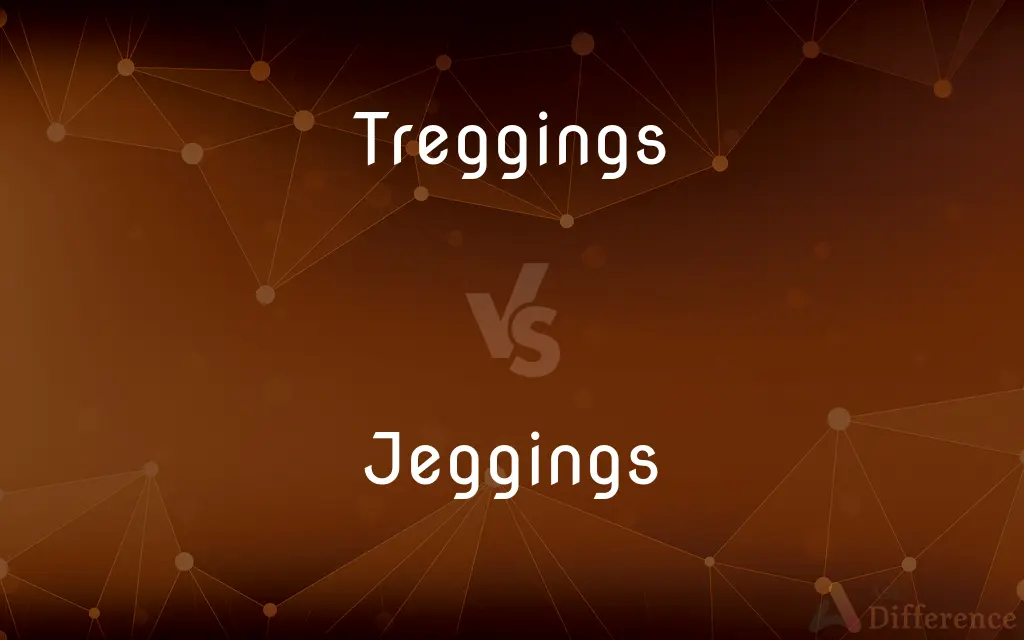Treggings vs. Jeggings — What's the Difference?
By Tayyaba Rehman & Urooj Arif — Updated on April 26, 2024
Treggings combine the style of trousers with leggings' comfort, featuring thicker fabric and often pockets; jeggings mimic jeans' appearance with softer, stretchier material.

Difference Between Treggings and Jeggings
Table of Contents
ADVERTISEMENT
Key Differences
Treggings are essentially leggings styled to look like trousers, often made from thicker fabrics to enhance their trouser-like feel, while jeggings are designed to resemble jeans and are typically crafted from a denim-look stretch fabric.
Treggings usually include features like pockets and sometimes come with a zip and button closure to mimic trousers more closely, whereas jeggings often have faux front pockets and a printed stitch to suggest jeans' details without actual depth or functionality.
The material of treggings often leans towards a blend that includes more polyester or viscose, providing a slightly stiffer feel suitable for formal wear, on the other hand, jeggings primarily use a softer, stretchier material like a cotton-elastane blend to closely imitate the comfort of leggings.
In terms of usage, treggings are suitable for work environments or occasions that call for a smart-casual dress code, while jeggings are more casual and are often worn for informal outings or where comfort is a priority.
The waistband in treggings is sometimes structured, similar to trousers, providing better support and a formal look; jeggings frequently feature an elastic waistband that emphasizes comfort and ease of wear.
ADVERTISEMENT
Comparison Chart
Style
Mimics trousers
Mimics jeans
Material
Thicker, often polyester or viscose blend
Softer, usually cotton-elastane blend
Pockets
Real pockets, sometimes zipped
Often faux or no pockets
Waistband
Structured, often with closure
Elastic, easy to pull on
Suitable Environment
Work, smart-casual events
Casual, everyday wear
Compare with Definitions
Treggings
A hybrid garment combining leggings and trousers for a structured yet comfortable fit.
She wore black treggings that looked sharp for her office meeting.
Jeggings
Typically features a soft, stretchable material that enhances mobility.
Her jeggings allowed her to move freely during her shopping spree.
Treggings
Comes in a variety of colors and patterns to match work attire.
She chose grey treggings to match her colorful top.
Jeggings
Available in various denim shades and distressing to mimic real jeans.
Her distressed jeggings looked almost like actual ripped jeans.
Treggings
Often features real pockets and closure systems.
The treggings had zippered pockets, adding practicality to style.
Jeggings
Often designed with faux pockets and minimal detailing.
The jeggings had faux pockets, maintaining a smooth silhouette.
Treggings
Suitable for professional and semi-formal settings.
Treggings are her go-to for presentations since they're both comfy and chic.
Jeggings
A fusion of jeans and leggings, offering the appearance of denim with the comfort of leggings.
She loves her blue jeggings for casual weekends.
Treggings
Designed to provide a formal look with the comfort of stretch fabric.
Her treggings paired perfectly with a blazer and heels.
Jeggings
Ideal for casual wear and everyday activities.
Jeggings are perfect for her day out with friends.
Treggings
Women's leggings that are designed to resemble a pair of trousers.
Jeggings
Jeggings () are leggings that are made to look like skin-tight denim jeans. The word is a portmanteau of the words jeans and leggings.
Treggings
A form of trousers having the characteristics of jeans and leggings.
Jeggings
Tight-fitting stretch trousers for women, styled to resemble a pair of denim jeans.
Jeggings
Denim leggings, or very skinny jeans.
Common Curiosities
What are jeggings?
Jeggings are leggings that mimic the appearance of jeans, usually made from stretchy denim-like fabric and often have faux details.
Are jeggings suitable for professional settings?
Typically, jeggings are considered too casual for professional environments, but they are ideal for relaxed and informal settings.
What is the main difference in the material of treggings vs. jeggings?
Treggings are usually made from a stiffer fabric blend for a formal look, whereas jeggings use a softer, stretchier material for comfort.
Do treggings come in different styles?
Yes, treggings are available in various styles, including those that mimic skinny trousers, straight cuts, and even those resembling more formal dress pants, offering versatility in professional and semi-formal wardrobes.
What are treggings?
Treggings are leggings designed to look like trousers, made with thicker fabrics and often featuring real pockets and closures.
Can treggings be worn for formal occasions?
Yes, treggings are appropriate for many work environments and semi-formal settings due to their structured appearance.
Can jeggings be dressed up for evening events?
While jeggings are primarily casual, they can be styled for more dressy occasions with the right accessories. Pairing them with a stylish top, heels, and elegant jewelry can elevate the look suitable for evening events.
Are jeggings available in different denim washes and styles?
Absolutely, jeggings come in a wide range of denim washes from light to dark, and include styles such as distressed, faded, and even patterned designs, mimicking traditional jeans in every aspect except the material.
What type of footwear works best with treggings and jeggings?
Treggings pair well with both flats and heels, making them versatile for changing from a professional day look to an evening out. Jeggings, being more casual, go great with sneakers, boots, and even sandals depending on the occasion and weather.
How do treggings differ from traditional leggings?
Unlike traditional leggings, which are typically very thin and primarily for casual or athletic wear, treggings are thicker and designed to resemble trousers with added features like real pockets and closures, making them more suitable for diverse settings, including workplaces.
Share Your Discovery

Previous Comparison
Learnings vs. Lessons
Next Comparison
Span vs. PeriodAuthor Spotlight
Written by
Tayyaba RehmanTayyaba Rehman is a distinguished writer, currently serving as a primary contributor to askdifference.com. As a researcher in semantics and etymology, Tayyaba's passion for the complexity of languages and their distinctions has found a perfect home on the platform. Tayyaba delves into the intricacies of language, distinguishing between commonly confused words and phrases, thereby providing clarity for readers worldwide.
Co-written by
Urooj ArifUrooj is a skilled content writer at Ask Difference, known for her exceptional ability to simplify complex topics into engaging and informative content. With a passion for research and a flair for clear, concise writing, she consistently delivers articles that resonate with our diverse audience.
















































